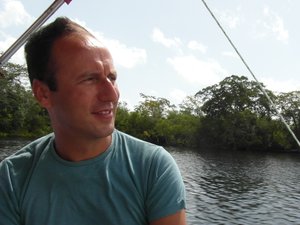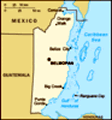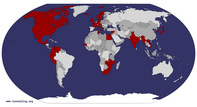Advertisement
Published: August 13th 2016

 Me
Me
Boat to Lamanai, up the New RiverDear All
Hello again, and greetings this time from Northern Belize – writing this one up from pretty much the remotest, quietest, most peaceful place on my trip so far – a small backpackers’ lodge just outside a tiny fishing village called Sarteneja, on the north-eastern tip of Belize. This really is off-the-beaten track, and it’s actually been pretty much this way for the last four days since I left Belize City. I feel like I’m exploring a part of the country which is little known to tourists, and this also being the low-season in Belize, it is especially quiet and remote. I have only met two other travellers like myself over the last four days, an English-Spanish couple based in Southampton, and they were on the same bus as me from Orange Walk to here, both happening to be heading for the same place to stay as myself: Backpackers’ Paradise. Now normally I would run a mile from anywhere with the name “Backpackers” in it, the name itself conjuring up images of just-out-of-school young twenty-somethings on their gap year, drinking lots. But this place really is different, and reminds me of an episode from ‘Ben Fogle’s New Lives in

 Me
Me
Top of High Temple Pyramidthe Wild’. I will relate more on this below.
Before I do so, I will start from where I last left off, I believe after having gratefully left the gritty Caribbean urbanism that is Belize City. As predicted, the last few days I’ve seen a much more relaxed, normal side to Belize, friendlier people, and a sunnier vibe overall. A two-hour bus journey northwards took me to the wonderfully-named Orange Walk, a town of only 16,000, beautifully located on the near-black New River which runs alongside the town and is home to a variety of birdlife, along with manatees and crocodiles. I have yet to see the latter in the wild here, but a boat trip on the river the other day, I caught a very brief glimpse of a manatee just before it sighted our boat and dived once more into the watery depths. The town had a more Spanish flavour than Belize City, with a smattering of the country’s Mennonite population, seemingly in town to sell their wares from their isolated communities deep within rural Belize.
This brings me on to the people of Belize: an incredibly diverse country, with what I find to be a
really interesting history. As with its neighbours, in pre-Hispanic times most of Belize was under the dominion of the individual city states of the ancient Mayans, who have left their remains behind in the form of ancient Mayan ruins, cities, temples and pyramids. In the 1500s, the Spanish tried to conquer the lands with an offensive arriving from the Yucatan peninsula – their presence barely lasted a century until the Mayans succeeded in repelling them, and they returned to Mexico in the 1600s. Next to arrive were British pirates, who found shelter and hideouts amongst Belize’s many offshore coastal islands and reefs, from where they could launch their plunders on Spanish gold and silver being shipped back to the Old World. Eventually, however, the pirates found it was more profitable to settle in Belize, and reap an honest living from logging its tropical hardwoods and exporting them back to England. These settled pirates became known as the British Baymen, being based on the western coast of the Bay of Honduras. The Baymen became civilised, and founded their trading centre on the site of present-day Belize City. The Spanish weren’t too happy about this, although they eventually ceded Belize to the
British in return for the latter’s territorial claims on the coast of Nicaragua. The country then became known as British Honduras, and began to import slaves from West Africa to work in the logging camps, and subsequently the sugar plantations. There’s a story from Guatemala also, that the Guatemalans ceded British Honduras to the British in return for the latter promising to build a road connecting Guatemala City to Belize City – that never materialised, and it seems the Guatemalans are still unhappy about this. In fact, a fair number of Guatemalan country maps seem to show Belize as being a part of that country, and that the present-day border is a matter of international dispute. I’m not sure about this, I think the UN pretty much confirms Belize as its own country, and that the border is accepted as it is. Anyway, British Honduras remained a part of the British Empire until as late as 1981, when it eventually gained its independence, and became known as modern-day Belize. Unsurprisingly, such a history has created a hugely diverse populace in terms of ethnicity. Today, the country counts Caribbean Creoles (descended from the slaves brought over from West Africa), Central American
Mestizos (mixed-race Spanish and indigenous peoples) and Mayans as its main ethnic groups, speaking the languages of Creole English, Spanish and Mayan respectively. The country also has sizeable populations of Garifuna (as mentioned in a previous blog), Chinese and South Asians. And finally, the group which I find the most fascinating, the Mennonites, who arrived here in the 1950s from Mexico after the latter demanded that they join the country’s social security programme. Mennonites live a strictly non-secular life, and refuse to recognise any country’s political structures or dominance – as such, they have not always been welcome around the world. I have encountered these enigmatic people during my time in Paraguay, and also briefly on a visit to see my Uncle in Canada (hi Uncle William!). I truly find them fascinating. There are generally two types of Mennonites: Old Order, and Progressive. The latter integrate more readily with the wider society, wear regular clothes and use more modern technology. The former are much stricter, they shun any form of technology, travel around in horse and cart, the men wear heavy trousers, braces and shirts, the women wear bonnets, dresses and tights. They live within their own communities, eking a
living out of the land, and interacting with outsiders only to sell their wares. They are extremely photogenic, though of course probably quite sensitive to having pictures taken of them. I managed to take a few discrete snaps, but I have yet to find out more about these elusive people – I find their lifestyle fascinating, but so distant. Perhaps one of these days I’ll be able to learn more about them from the inside.
And definitely, since my journey from Belize City, I have learnt more about the peoples of this country as I have travelled. Belize City was more Creole-based, with sizeable proportions of the other ethnic groups. I did get the feeling whilst there that the ethnic groups did not always get along amicably side by side, though as I’ve journeyed further north the differences seem to have relaxed and there seems to be more integration. Northern Belize is predominantly more Spanish-based, being closer to the Mexican influence. People here speak more Spanish, although I find both their Spanish and their English quite difficult to understand – they seem to mix the two languages quite a bit, and add in a bit of Creole (with its
extra influences from French and West African languages), combining everything, including the Spanish, with a beautifully lilting, though at times difficult to comprehend, Caribbean twang. People are generally friendlier up here, though there is still the presence of the overly macho side to the guys which they could do with toning down a little. My time up north has overall been much more relaxed, and much friendlier.
So upon arriving in Orange Walk, I checked into the blissfully tranquil Lamanai Riverside Retreat, a small bar/restaurant with three rustic cabins nestled on the banks of a peaceful stretch of the New River. I spent some happy times there enjoying a coffee, breakfast etc. on its banks, looking out for any crocodiles or manatees which inhabit the waters but not having too much luck, and breathing out after Belize City. My full day there also involved a wonderful tour of the nearby Lamanai Mayan ruins. This began with a 24-mile boat journey upstream with a tour guide called Wilfredo, two French tourists, and a group of four El Salvadorean Americans. After the stunningly scenic trip upriver, we disembarked in the jungly setting of Lamanai, reminiscent of any of the Indiana Jones
films with its temples and pyramids, abandoned only as recently as the 1800s, but the jungle already laying claim once more to it, and trees growing out of the ancient stone structures. It was much smaller and quieter than Tikal, but this also meant that it was less touristy and felt much more authentic. Its unique claim to fame also lies with it being the only Mayan site to have been completely occupied throughout the whole of Mayan history: between 1500 BC and 1800 AD. Many other famous Mayan sites, including Tikal, were the basis of city-states which came and went, but Lamanai remained continually inhabited for a record 3300 years – it seems that they are only just being able to uncover its treasures, as lack of archaeological funding means that there is much left to be discovered. After three hours of the guided tour (not my favourite, I prefer to do things alone, but the tour guide preferred that I stuck with the group) and climbing a couple of the pyramids, we had lunch on some shaded benches and made the blissful return back downstream, stopping off briefly to take a couple of photos of the Old Order
Mennonite village of Shipyard, and towards Orange Walk again. A wonderful day, and rounding off my stay in Orange Walk very nicely.
And finally, on Thursday morning, I took another two-hour bus trip, this time along a dusty dirt-track, to the little-visited fishing village of Sarteneja, in the north-east corner of the country. As mentioned, it couldn’t get more remote and chilled-out than this, especially again as it’s currently the tourist low-season. Whilst this has its benefits, it has also had its problems, and I’m actually quite looking forward to moving on to a bit more action this afternoon.
This Backpackers’ Paradise is indeed unique, and as mentioned, it feels as if I’m in an episode of ‘Ben Fogle’s New Lives in the Wild’. The place is run with much love and pride by a wonderfully positive and energetic French lady called Nathalie, a good contender I’d say for an episode with Ben Fogle. It is set in three acres of jungle and scrubland, with a number of very rustic cabins scattered around the place. I’m staying in one of the more “upmarket” cabins, with private bathroom and its own mosquito-netted veranda. Three horses and two dogs wander

 White Water Lilies
White Water Lilies
New River, Orange Walk Districtfreely around the place, and tropical fruit trees, including avocado and lime, dot the place. It is deliciously rustic and rural, and I’ve had a unique few days here. The first night it was tricky to sleep as it’s just so hot, the fan did little to cool things down. The second night I found a scorpion in my room just before lights out, so I again found it a bit tricky to switch off for sleep, double-checking under my pillow, under my bed, above my bed and so on, but in the end I actually slept really well. I was told that scorpions are not too dangerous around here, and the English-Spanish couple whom I met on the bus on the way here were able to walk the scorpion out of my room for me – I wasn’t sure what to do with it, but they seemed to have much more previous experience of dealing with jungle nasties than myself.
I had planned to do a bit of sightseeing whilst here, but again, I was hit with the issue of it being the low-season with tourists. I rented a bike for the day from Nathalie, and cycled three

 Old Houses
Old Houses
Orange Walkmiles south-westwards, towards the Shipstern Nature Reserve, a highly recommended place for wildlife-viewing and bird-watching. I was hoping to do a guided tour, hopefully towards the Shipstern Lagoon, a good spot apparently for crocodile-watching. I also heard you could arrange from there an eco-tour of nearby Little Belize, another Old Order Mennonite community not far from here. Unfortunately, after a hot and sweaty three-mile cycle ride along the dust road, the Shipstern’s visitors’ centre was closed, as was its famous butterfly house. Three workmen were able to point out a short nature trail, which I took, but I took it far too quickly unfortunately due to its massive bug-problem, perhaps due to it currently being the country’s wet season. The place was infested with mosquitoes - any time I stopped for just a few seconds, to take a photo or to read one of the trail signposts, the biting and whining bugs closed in rapidly. Nathalie had recommended I bring an extra t-shirt, to act as a horse-tail-type of bug fan, swatting continually around my neck and face – this worked a treat, I don’t know what I would have done without it! As soon as I stopped swatting, the

 Old House
Old House
Orange Walkwhining and biting began almost instantaneously. On the trail I met two workmen who were clearing the path, and chatting briefly with them there was a near-haze of mosquitoes flying around them, I really don’t know how they worked there all day…! My walk did involve a climb up a 30-metre high observation tower, definitely not for the faint-hearted or vertigo-sufferers – the steps were tiny and went practically straight up, and the whole thing was made of caged metal, so you could see straight down even from the top. There was a wonderful view from up there, a refreshing breeze, and no mosquitoes, so it was definitely worth the climb. After negotiating my way down the steps again very slowly, I cycled back to the Backpackers’ Paradise to do some serious chilling for the afternoon, before making it into the village to try to find a bite to eat in the evening.
Whilst the town is spectacularly situated on the Caribbean coast, with turquoise waters, palm trees and a blissful tropical vibe, nothing much was really open. In fact, although I’d found some food the day before in a local eatery called “Pablito’s”, everything last night seemed closed,
and I’m not sure why. Even Pablito, whose food joint the locals said was always open, told me he had made no food that evening – I’m still puzzled as to why. Faced with no alternative, I was just about to buy some pot-noodle type things and some unappetising tinned chicken-sausages from the local food shop, when I was inspired to try walking around a bit more – this time I happened upon two lovely ladies who were making burritos on the street. I normally avoid street food on my travels, due to my sensitive stomach, but it looked like I was faced with three alternatives: no food, pot-noodle and tinned sausages, or some burritos. I chose the latter, without meat or chicken to be on the safe side, and at least it satisfied. I ended up with a distinct and not-too-pleasant after-taste of lettuce afterwards, which I soon saw to with a good swig of my trusty travel brandy – it comes in handy in the unlikeliest of situations, I never travel without it! Today, again, there are no eateries open, as it’s Saturday, and along with Sunday, is a day where most things in Belize seem to be

 Mennonites
Mennonites
Orange Walkshut. Fortunately, Nathalie makes some delicious breakfasts, and I had a double portion today, just to make sure I was eating enough. She was also able to order in for me some barbecued chicken, I’m not sure from where, for lunch. But although this place has been very relaxing, I’m sure looking forward to a place where restaurants are easier to find, and are generally open…!
In fact, this very afternoon I’ll be taking the daily ferry across the Corozal Bay, towards Corozal Town. I’ll be staying one night there, in an apparently nice, upmarket hotel, before moving on tomorrow morning to Chetumal, across the border to the north, and back into Mexico again. My journey continues for eight more days from there, through the Yucatan Peninsula, before finally winding up at Cancun for my flight home. I’m especially looking forward to this part of my journey, as I’ll be following pretty much in the footsteps of a trip my parents made to the Yucatan Peninsula last summer, and heard some good stories about and good places to visit.
I’m also looking forward to some good (and freely available!) food, and although my cabin here has been comfortable

 Belikin
Belikin
Belize's top beer of choiceand refreshingly rustic, I’m now looking forward to some serious air-conditioning, in-room WiFi, and scorpion-free floors…!
So these last few days have been very relaxed and have afforded some decent time to wind down. I’m looking forward now for a bit of winding up again (in a positive way of course), and will probably write my next one now from Mexico!
So, until the next time, sending my second and final greetings from Belize, and thank you for reading!
All the best
Alex
Advertisement
Tot: 0.116s; Tpl: 0.028s; cc: 15; qc: 38; dbt: 0.0666s; 1; m:domysql w:travelblog (10.17.0.13); sld: 1;
; mem: 1.2mb


















































RENanDREW
Ren & Andrew
Scorpion walking...
The image in my head of 'walk the scorpion out of my room' was quite hilarious... and I'm so glad they didn't kill it. I think your bottle of 'travel brandy' needs a bit more explanation... I assume for medicinal purposes :)